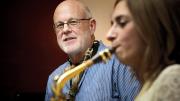In 1979, musician and educator John Payne ’67 faced a problem. He’d been teaching a lot of private students, who went home to practice and then returned for the next lesson—fine. But a lifetime in music had also taught Payne that playing with others not only increased enjoyment immensely, but motivated people to learn music better and to keep practicing and playing. “Where do I send people to play in groups?” he asked himself. “To play in groups, you had to be good. We needed a place where people could be bad together!”
The answer was to start a different kind of music school, the John Payne Music Center (JPMC), now a nonprofit. Operating at a limited skill level was, he knew, no barrier to musical pleasure. Despite having played with Van Morrison (on the celebrated Astral Weeks album, among others), Phoebe Snow, and Bonnie Raitt ’72 (on her Give It Up album), and appearing on NBC’s Tonight Show and Saturday Night Live, Payne realized that “Some of the greatest times I’ve had came when I was no good at all”—like playing a small, plastic end-blown flute called a Tonette as a fourth-grader, where “the level of musicianship of the group was very, very basic, to put it as delicately as possible.” He adds, “Enjoyment is not proportional to how good you are. The value of music comes in the joy you take from it, and give to others.” In an essay, “Reversing the Dwindling Spiral of Musical Enjoyment” (see his entry under “Teachers” at www.jpmc.us), and at his school in Brookline, Massachusetts, Payne rejects what he calls “the tyranny of competence,” noting that the first question people often ask when they learn that someone plays an instrument is, “Is she any good?” Payne suggests that “Is she having fun with it?” might be more appropriate.
The JPMC forms jazz, rock, and R&B ensembles of students (typically four to eight) playing at roughly the same levels, and not necessarily very advanced ones. There are adult students ranging in age from their twenties to their seventies, and youth ensembles for 10- to 18-year-olds. Six teachers lead the nearly two dozen current groups, each of which meets for 90 minutes once a week. Several times a year, they play at Ryles Jazz Club in Cambridge; some have performed elsewhere, even landing paid gigs. Students thrive in the groups, which flourish as members play together for months, even years. In another broadside, Payne asserts that “the joy of group music making—wherein you are co-creating the music—has the potential to far exceed the joy possible in just being the audience to others’ music. In fact, this great joy is the reason I became a musician. Why else would anyone do it?”
A Thelonius Monk concert that Payne attended as a teenage Dixieland clarinet player proved a watershed moment. Monk “blew my mind—the depth of the music,” he recalls. Within months, he had purchased about 100 albums and taken up tenor sax. Immersed in music, he took time off from college, edited math books at Houghton Mifflin, and eventually earned a degree in philosophy. He had a successful professional career as a sideman, and formed the John Payne Band, which released four albums and performed for several years. During one road trip, a drummer emerged from a phone booth to announce that he’d just become a dad. Payne, who was married, wanted children (he now has four) and decided to leave the touring life behind: “I didn’t want to be getting out of a phone booth at a truck stop in California when my wife had a baby.”
Hence he settled in his hometown of Boston, founded the JPMC, and began challenging orthodoxies of musical education—among them, that students cannot (even should not) be taught to improvise. “No one was teaching improvisation,” he says, acknowledging the paradox: “How do you teach someone to be free?” The clue emerged from his recognition that “music is a language. When toddlers learn to speak English, they don’t read a script. In some ways, that’s more difficult than improvising music!”
Payne has developed methods of teaching improv. Using a background track of a rhythm section—bass, drums, and piano—he’ll start by getting a student to improvise by creating a melody from the notes of one scale, say F major. “Eighty to 90 percent can do that right away,” he reports. Then he’ll get students to change scales in the middle of the piece while improvising. With experience, the student starts to see and hear patterns (like chords) rather than single notes: “You intuitively grasp an A-flat seventh chord as a gateway to a set of possibilities,” Payne explains. “That streamlines things, so you can go faster. Eventually you can play through the chord changes, and when you can do that, it’s a whole new universe.”







